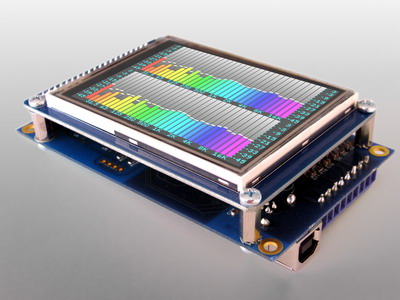What is CAVA

CAVA is a software spectrum analyzer for Linux devices. It will happily run on a Raspberry Pi, and here I will show you how to install it as a Roon Endpoint, with CamillaDSP. This post will be split into chunks as I write it.
After doing this I tried a different screen and it nuked my system, so this guide is incomplete.
I used this OTS part instead of CAVA. See post #8

Requirements
You will need:
Please note - this is what worked for me. I'm writing this as I do it. There are probably better ways of doing it, and I would be happy to edit if people share those methods. If you try this, it's your responsibility to make sure nothing bad happens. If it doesn't work I will try and help, but Google is probably better.
Installation
If you've never worked with a Raspberry Pi before, they're very easy to use.
First we need to install an operation system onto a MicroSD card. The easiest way is to download the official imager from Raspberry Pi - https://www.raspberrypi.com/news/raspberry-pi-imager-imaging-utility/
Follow the instructions, and create an image on your MicroSD card. I used Ubuntu Server 21.10
When it has finished, insert the card into your Raspberry Pi, with a network cable and screen attached. Apply power and it should boot up. Using your main computer connect to the device via SSH (https://www.raspberrypi.com/documentation/computers/remote-access.html). The command should present a log in screen with a login prompt.
Default log in is 'ubuntu', and the password is also 'ubuntu'. When you type your password nothing will show on the screen, but that is normal. You will be prompted to change the password, and then the device will reboot. Repeat the SSH log in.
The first thing we want to do is update the software to the latest version. To do that we need to be a 'super user'. You can do that by using the following command:
the username will change from 'ubuntu@ubuntu' to 'root@ubuntu'. Use the following to install any updates:
You will probably need to reboot at the end of the upgrade.
Log in again, and now we can start installing software.

CAVA is a software spectrum analyzer for Linux devices. It will happily run on a Raspberry Pi, and here I will show you how to install it as a Roon Endpoint, with CamillaDSP. This post will be split into chunks as I write it.
After doing this I tried a different screen and it nuked my system, so this guide is incomplete.
I used this OTS part instead of CAVA. See post #8

Requirements
You will need:
- Raspberry Pi (I'm using v4 here)
- MicroSD card for operating system (16GB should be fine)
- A screen of some sort
- Another computer for installing the operating system
- A terminal program. Putty is good for Windows, and Mac OS has one built in.
- An internet connection
Please note - this is what worked for me. I'm writing this as I do it. There are probably better ways of doing it, and I would be happy to edit if people share those methods. If you try this, it's your responsibility to make sure nothing bad happens. If it doesn't work I will try and help, but Google is probably better.
Installation
If you've never worked with a Raspberry Pi before, they're very easy to use.
First we need to install an operation system onto a MicroSD card. The easiest way is to download the official imager from Raspberry Pi - https://www.raspberrypi.com/news/raspberry-pi-imager-imaging-utility/
Follow the instructions, and create an image on your MicroSD card. I used Ubuntu Server 21.10
When it has finished, insert the card into your Raspberry Pi, with a network cable and screen attached. Apply power and it should boot up. Using your main computer connect to the device via SSH (https://www.raspberrypi.com/documentation/computers/remote-access.html). The command should present a log in screen with a login prompt.
Default log in is 'ubuntu', and the password is also 'ubuntu'. When you type your password nothing will show on the screen, but that is normal. You will be prompted to change the password, and then the device will reboot. Repeat the SSH log in.
Bash:
login as: ubuntu
[email protected]'s password:
Welcome to Ubuntu 21.10 (GNU/Linux 5.13.0-1008-raspi aarch64)
* Documentation: https://help.ubuntu.com
* Management: https://landscape.canonical.com
* Support: https://ubuntu.com/advantage
System information as of Fri Nov 5 18:17:42 UTC 2021
System load: 0.22 Temperature: 55.0 C
Usage of /: 17.0% of 14.30GB Processes: 186
Memory usage: 15% Users logged in: 0
Swap usage: 0% IPv4 address for eth0: 192.168.1.160
0 updates can be applied immediately.
The list of available updates is more than a week old.
To check for new updates run: sudo apt update
Last login: Fri Nov 5 18:17:11 2021 from 192.168.1.175
To run a command as administrator (user "root"), use "sudo <command>".
See "man sudo_root" for details.
ubuntu@ubuntu:~$The first thing we want to do is update the software to the latest version. To do that we need to be a 'super user'. You can do that by using the following command:
Bash:
sudo suthe username will change from 'ubuntu@ubuntu' to 'root@ubuntu'. Use the following to install any updates:
Bash:
apt update && apt upgradeYou will probably need to reboot at the end of the upgrade.
Bash:
rebootLog in again, and now we can start installing software.
Last edited:

